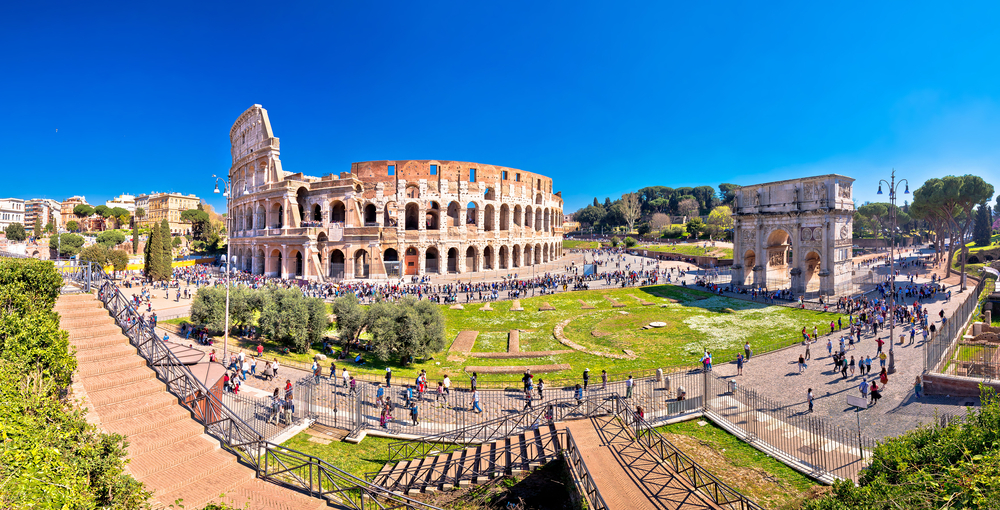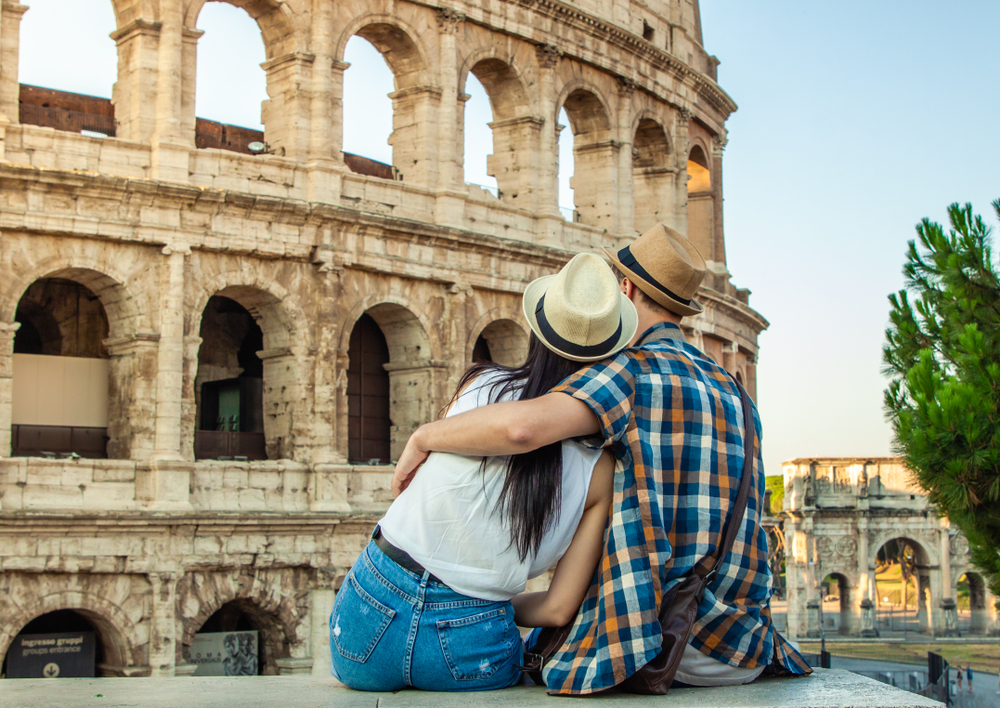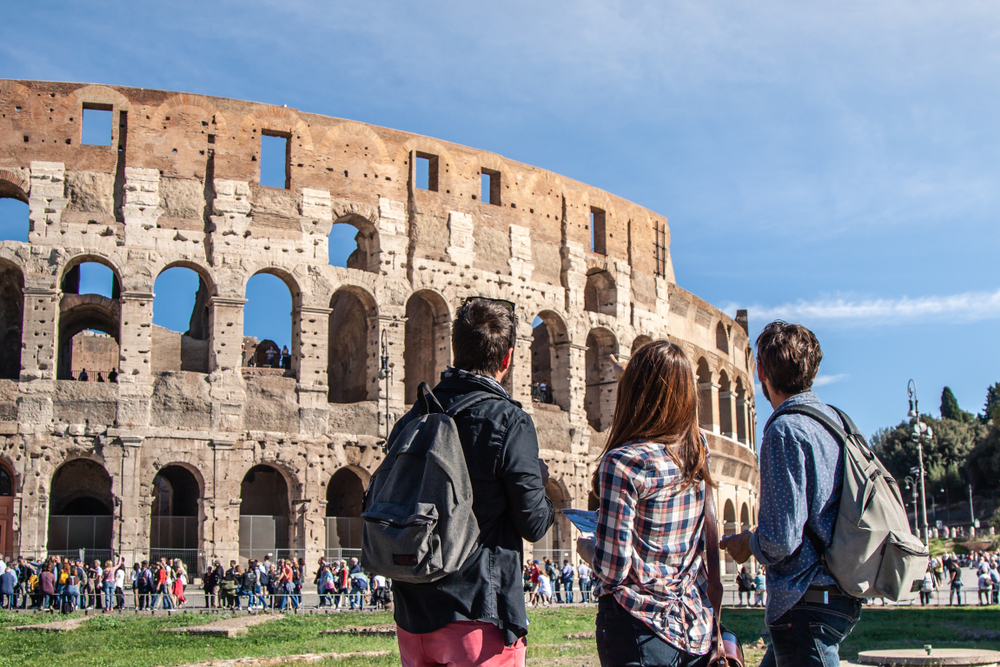The Colosseum is a symbol of ancient Roman engineering and architectural brilliance. Built between 70-80 AD, this iconic amphitheater hosted gladiatorial contests, animal hunts, and mock sea battles, entertaining up to 50,000 spectators. Its design ensured efficient crowd management.
Today, as a UNESCO World Heritage site, it attracts millions who explore its grandeur and the rich narratives of ancient Rome.
This guide covers everything you need for an optimal visit to the Amphitheatrum Flavium, the Colosseum’s original name, including how to get there, opening times, the best times to visit, main attractions, facilities, travel tips, and nearby restaurants.
Enjoy your reading!
Trevi Fountain Quick Facts
Tickets to Colosseum

There are several types of tickets available for the Colosseum, and booking in advance is highly recommended due to its popularity:
- Standard Ticket: Includes entry to the Colosseum, Roman Forum, and Palatine Hill. This ticket is valid for two consecutive days.
- Full Experience Ticket: Includes access to the underground, arena floor, and upper tiers, along with the Roman Forum and Palatine Hill.
- Skip-the-Line Tickets: Available through Roma Pass or other tour operators, these allow priority entry, saving you time during peak seasons.
Below you can find most popular Colosseum tours and tickets:
Things to Do at the Colosseum

Explore the Colosseum’s Main Sights:
- The Arena Floor: Walk where gladiators once fought for their lives. The reconstructed arena floor provides a unique perspective of what it must have been like to stand in the middle of the spectacle.
- Underground Chambers: Discover the hidden underground chambers where animals were kept, and gladiators prepared before entering the arena. This area offers a behind-the-scenes look at the mechanics of the Colosseum’s spectacles.
- The Upper Levels: Head to the upper levels of the Colosseum for panoramic views of the arena and the surrounding landmarks, including the Roman Forum and Palatine Hill.
- The Exterior Façade: Admire the impressive outer walls, adorned with Corinthian, Doric, and Ionic columns. The arches and architectural details of the exterior remain some of the best-preserved elements of the structure.
Location & How to Get to the Colosseum

The Colosseum is located in the heart of Rome and is easily accessible by public transport:
- By Metro: Take Line B (blue line) to the Colosseo stop. The Colosseum is directly outside the station.
- By Bus: Bus lines 75, 81, 175, 673, and 87 all stop near the Colosseum.
- On Foot: If you’re staying in the city center, the Colosseum is a 15-minute walk from landmarks such as the Roman Forum and Piazza Venezia.
You can find official Public Transport Maps via this link
- Address: Colosseo, Piazza del Colosseo, 1, 00184 Roma
- Google Maps: Colosseum Location
Opening Hours and Best Time to Visit the Colosseum

The Colosseum is open every day of the year, except for December 25th and January 1st. Here are the opening hours:
- Winter Hours (October to February): 9:00 AM – 4:30 PM.
- Summer Hours (March to September): 9:00 AM – 7:00 PM.
Last entry is always one hour before closing, and it’s advisable to check the official website for any changes during public holidays.
Best Time to Visit
- Early Morning or Late Afternoon: These are the best times to avoid large crowds and enjoy a more peaceful experience. Mornings are ideal for cooler temperatures and fewer people, especially during the summer months.
- Shoulder Seasons: Visiting in spring (March to May) or autumn (September to November) offers a pleasant climate with milder temperatures and smaller crowds compared to the busy summer months.
- Avoid Peak Times: If possible, avoid visiting the Colosseum during midday in the summer (June to August), as the crowds are largest, and the heat can be intense.
By planning your visit during quieter times, you can better appreciate the Colosseum’s architecture and history without the stress of navigating through large tourist groups.
How Much Time Should I Plan to Visit the Colosseum?

The time needed to visit the Colosseum depends on how much you want to explore. Here's a quick guide:
Quick Visit (1-2 hours):
- Arena Floor & Hypogeum: 30-45 minutes
- Gladiators' Gate & Emperor's Box: 15-20 minutes
- Terraces: 15-20 minutes
Moderate Visit (2-3 hours):
- Arena Floor, Hypogeum, Gladiators' Gate, Emperor's Box: 45-60 minutes
- Terraces: 20-30 minutes
- Colosseum Museum: 30-45 minutes
In-Depth Visit (3-4 hours):
- Full Colosseum Tour: 1.5-2 hours
- Colosseum Museum: 1-1.5 hours
- Gladiator School: 30-45 minutes
Plan your visit time based on how much you want to explore and learn about the Colosseum's fascinating history!
History of the Colosseum

Before we go further into details, let's take a look at the history of the Colosseum using a timeline to give you an easy-to-understand overview.
Good to know:
The name Colosseum isn't derived from its massive size, as some might guess. It actually comes from a colossal statue that once stood near the amphitheater. Here's the breakdown:
- Originally, the Colosseum was called the Flavian Amphitheatre (Amphitheatrum Flavium in Latin). This refers to the Flavian dynasty, the emperors who commissioned and built it.
- The more popular name, Colosseum, is believed to be derived from a colossal statue of Emperor Nero. This statue was modeled after the Colossus of Rhodes, a giant statue in the ancient world.
- Emperor Hadrian, who ruled later, moved the statue to a position beside the amphitheater. While the statue itself is no longer there, the name Colosseum stuck.
Facilities and Accessibility at the Colosseum

- Restrooms: Located near the entrance and throughout the site.
- Souvenir Shops: Available inside and outside the Colosseum, offering books, postcards, and Roman-themed memorabilia.
- Accessibility: The Colosseum is equipped with ramps and elevators, ensuring that visitors with mobility challenges can explore the site comfortably.
What You Should Know Before Visiting – Visiting Rules

- Dress Code: No specific dress code, but comfortable clothing and walking shoes are recommended due to uneven ground.
- Bag Restrictions: Large bags and backpacks are not allowed inside. Small bags may be permitted but will be subject to security checks.
- Photography: Photography is allowed, but the use of tripods or drones is prohibited.
- Food and Drink: Eating and drinking are not allowed inside the Colosseum.
Traveler Tips for the Colosseum

- Arrive Early: To avoid the crowds, aim to arrive at the Colosseum when it opens.
- Stay Hydrated: Bring a water bottle, especially during the summer months. Water fountains are available on-site.
- Plan for Extra Time: If you’re visiting the Roman Forum and Palatine Hill as well, allow at least 3-4 hours for your combined visit.
- Book in Advance: The Colosseum is one of the most popular attractions in Rome, so booking skip-the-line tickets or tours in advance is highly recommended.
The Colosseum at Night

Light Shows
- Viaggio nei Fori: One of Rome's top light shows at the Forum of Augustus, using virtual reality to take you back in time, from Michelangelo's era to the Roman Empire.
- Other Light Shows: Experience immersive light displays at Domus Aurea, Caracalla Baths, Circus Maximus, and the Forum of Julius Caesar.
- Colosseum by Night: Explore the Colosseum in a peaceful, crowd-free setting with exclusive access to areas like the Arena floor, where gladiators fought. Note: This tour does not include the Roman Forum or Palatine Hill.
- Underground & Arena Floor Tour: Discover the Colosseum’s underground dungeons and the arena floor by moonlight, reliving the historic battles.
- VIP Night Tour: Skip the lines and enjoy a guided tour with exclusive access to the arena floor after dark, offering a truly unique experience.
Night Tours
Visiting Rules for the Colosseum

When visiting the Colosseum in Rome, it’s essential to be aware of what you can bring and what is not allowed. Here are some guidelines to ensure a smooth and enjoyable experience:
- Bags, backpacks, or purses not meeting the Bag Policy guidelines.
- Coolers, baskets, packages, or containers.
- Alcoholic Beverages, Bottles, and Cans (except factory-sealed water bottles).
- Illegal Drugs and Weapons (firearms, knives, explosives, fireworks, lighters, laser pointers).
- Professional cameras, selfie sticks, tripods, and recording equipment.
- Banners, sticks, poles, inflatables, balls, and unsliced fruits or vegetables.
- Umbrellas, balloons, strollers, skateboards, and chairs.
- Noise-making devices (whistles, horns, instruments).
- Pets (except service animals).
- Smoking and smoking implements.
Facilities at the Colosseum

- Restrooms: Available on-site for visitors.
- Café: No café inside, but nearby options are available for snacks and drinks.
- Restaurant: No on-site restaurant. Explore nearby eateries for meals.
- Museum Shop: Located on the second level, offering souvenirs like t-shirts, keychains, and Roman-themed items.
- Wheelchair Accessibility: Ramps and elevators available. Check for specialized guided tours.
- Stroller Accessibility: Strollers allowed, but lightweight, foldable ones are recommended due to uneven terrain.
Travel Tips for the Colosseum

- Book Tickets Online: Avoid long queues by purchasing tickets in advance, especially during peak seasons.
- Visit off-peak: Opt for early mornings or late afternoons to avoid crowds.
- Choose the Right Ticket: Decide between a basic ticket or one that includes the Arena Floor, Hypogeum, and Gladiator School.
- Guided Tour: Gain deeper insights with a guided tour.
- Dress Comfortably: Wear comfortable shoes and weather-appropriate clothing.
- Stay Hydrated: Bring a water bottle, especially in warm weather.
- Respect the Atmosphere: Keep noise to a minimum and be considerate of other visitors.
- Admire Details: Take time to appreciate the statues, arches, and architectural beauty.
- Explore Underground: Discover the Hypogeum, where gladiators prepared and animals were kept.
- Climb to Terraces: Enjoy panoramic views of Rome from the upper terraces.
- Visit the Museum: Learn more about the Colosseum’s history through exhibits and artefacts.
- Nearby Attractions: Explore the Roman Forum and Palatine Hill for a complete experience.
- Allow Time: Plan 2-3 hours to fully enjoy the Colosseum and its surroundings.
- Accessibility: Use accessible entrances on Via Celimontana and elevators for the Arena Floor and Hypogeum.
- No Dress Code: Unlike churches, there’s no formal dress code, but wear practical attire for uneven surfaces and open-air areas.
Top Attractions Around the Colosseum

- Roman Forum: (0.2 miles / 0.3 km, 5-minute walk)
Ancient hub of Roman life with temples, basilicas, and government buildings. Stroll through history among well-preserved ruins. - Palatine Hill: (0.3 miles / 0.5 km, 7-minute walk)
Explore imperial palaces and enjoy panoramic views of Rome. A blend of mythology and history amidst lush greenery. - Capitoline Museums: (0.5 miles / 0.8 km, 10-minute walk)
A treasure trove of classical sculptures and Renaissance art. Highlights include Marcus Aurelius' statue and the stunning collections in Palazzo Nuovo. - Arch of Constantine: (0.1 miles / 0.2 km, 2-minute walk)
A monumental arch celebrating Emperor Constantine’s victory. Admire the intricate sculptures and reliefs. - Circus Maximus: (0.7 miles / 1.1 km, 15-minute walk)
Ancient chariot racing stadium now a peaceful park. Imagine roaring crowds as you enjoy a leisurely walk.

The Colosseum is just the beginning of your journey through Rome’s history. Nearby, explore the ancient ruins of the Roman Forum and enjoy breathtaking views from Palatine Hill. Also Just a short walk away, visit the iconic Pantheon for a glimpse of Rome's architectural brilliance.
These iconic sites, along with the Colosseum, offer a captivating glimpse into the heart of ancient Rome. Plan your visit to experience these must-see attractions and immerse yourself in the timeless story of the Eternal City.

